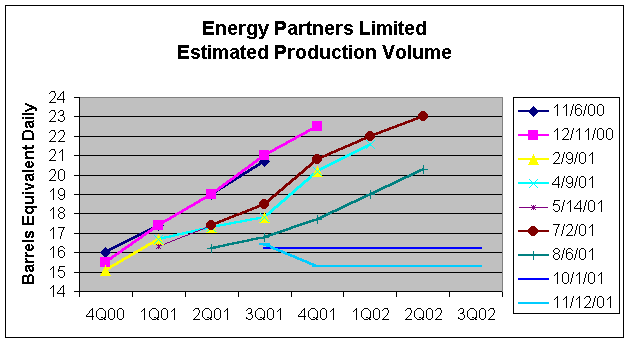November 19, 2001; What Went Right at Energy Partners?
More likely investors are asking the inverse of the question in our
subtitle as the stock of the micro cap company has come under quite a bit of
selling pressure. Coming public a
year ago, Energy Partners Limited now trades at less than half the stock price
of its initial offering. Although
the stock appreciated 28% while our Strong Buy was in place from April 27
through June 29, it has declined sharply as we continue to carry a Buy rating on
it.
Our projections of natural gas and oil volume that the company would achieve this year were too optimistic. For example, soon after the IPO our volume projection for the third quarter of 2001 just ended was about 21 thousand barrels equivalent daily (mbd) (see Chart). Actual volume was closer to 15 mbd. Instead of advancing sharply, volume has stayed basically flat.

Here is what has gone right. The
company has low leverage with a debt to present value ratio of only 0.17.
That leaves EPL in a good position to do a deal when the market is
depressed rather than having used up debt capacity when the market was
overheated. Half of the company’s
current value, the East Bay field, was acquired on a timely basis in the
previous downturn.
Management has also limited risk in its spending program.
The guideline is to spend only cash flow and save debt for deals.
Yet that sensible rule is contributing to lower volume in the current
quarter. EPL has already spent most
of its budget for the year while lower commodity prices are resulting in a lower
current rate of cash flow generation. With
little new drilling taking place now there is little new production expected in
the next few months to offset natural decline of existing production.
Within the spending program, management limits uncertain exploration to
about 10%. The other 90% is spent
on more certain development. That
rule too makes sense, but there is a subtle point that creates another
short-term problem for the stock. More
than half of the exploration went to a single well that was unsuccessful.
The well happened to be on the largest prospect that we highlighted as
having a chance to expand greatly the company’s reserves.
In the future management is more likely to seek more partners to share
exploration risk. The dry hole was
in the Bay Marchand area where EPL has an 80% interest. Had the well been successful, 80% would have looked good.
Since the well was unsuccessful, 50% would have looked more prudent.
Having been too optimistic we are going to be more cautious.
We are now looking for a volume decline in the current quarter and a flat
trend thereafter. Considering that the company is reinvesting all of its cash
flow, there are good chances that the volume trend can show some upward movement
next year. We keep our Buy rating
intact and will be patient about expecting gratification.